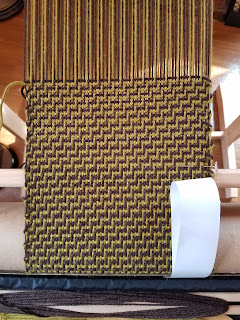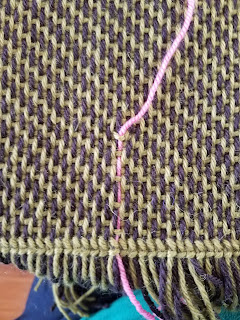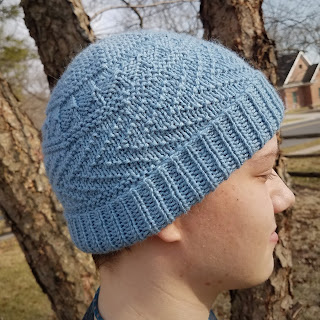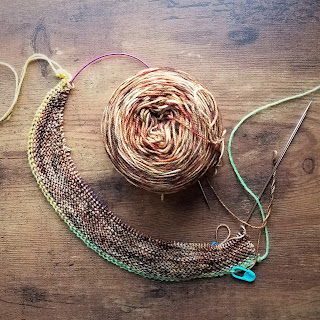A twill fabric is different, though. This project is a 1/2 twill, meaning the weft goes under 1 thread and over 2 threads...and the pattern sort of travels. There are 3 steps:
- Weft goes under thread 1, over 2, and over 3
- Weft goes over 1, under 2, and over 3
- Weft goes over 1, over 2, and under 3
This is possible on a rigid heddle loom if you use 2 heddles. I really appreciate the Weave-alongs that Liz does because she provides video support for every step of the project, making something new and conceptually challenging become completely doable.
I started this project by stash diving... I am keenly aware that the Maryland Sheep & Wool Festival is coming, and I want to reserve any fiber purchases for the festival! I tried several yarns on my sett checker. I originally intended to use this Jaggerspun sport, but it is a bit too thin... plus the two colors I have aren't high contrast, which I wanted for this:
Back to the stash looking for DK yarn. I was hopeful about this HipStrings Buoy DK and the contrast between blue and green was acceptable, but I realized I didn't have enough yardage for the project: Like Goldilocks, I got it right on the 3rd try. This is Nashua Handknits Julia from deep stash (I got it when The Mannings went out of business in 2015) and though it's worsted weight, it just seems to work right sett at 8 (on the right). I only have 2 heddles in size 8 and 5 (not 10 or 12) so this was important. And the dark brown and grungy green have great contrast! Julia is 50% Wool, 25% Alpaca, 25% Mohair and it's a delicious yarn:Liz encouraged us to warp with the indirect technique. I can warp directly without thinking much at all, but indirect is still a bit shaky for me. I decided to embrace the challenge and pulled out my warping board. I also wound one dark end and one light end at the same time, which cut down on winding time by 50% and looked pretty to boot: The next step required my full wits, so I waited until Sunday morning when the light was good and my brain was rested. I took my loom off the stand and put it on the table, over a yoga mat to keep it from sliding (this is a new improvement). Not having a "cross keeper," I put my potholder loom down as a way to sort of grab the threads when they are not in my hand. I felt I needed both hands free to deal with the threading hook and two heddles. This was the setup right before I cut the ends and released the cross: And here we are, all threaded for twill!
I tied on to the back beam and then packed it before tying on to the front beam. Then I was ready to weave.
I chose to weave 6" with a single color at each end (one end light, one end dark). The main part of the scarf uses both weft colors and alternates one pick light, one pick dark, in the twill pattern. Here is how it looked as I wove - so pretty!
The register tape is a guide that helps me keep track of length.
I carefully inspected my cloth after it came off the loom. I was thrilled to find only one float, and it was a warp thread float (which is easier to fix) and only a couple inches away from the end (also nice and easy). You can see it here. The purple thread is the header...just waste yarn:
For twill, Liz advised us to correct the mistake on the back of the fabric and to weave in a contrasting color of scrap yarn to keep track of the placement of the warp end we are replacing. I used pink:Then I picked out the problematic brown warp thread, and needle wove it again next to the pink thread - like this:
Now let's check on the front side: All good!
































































